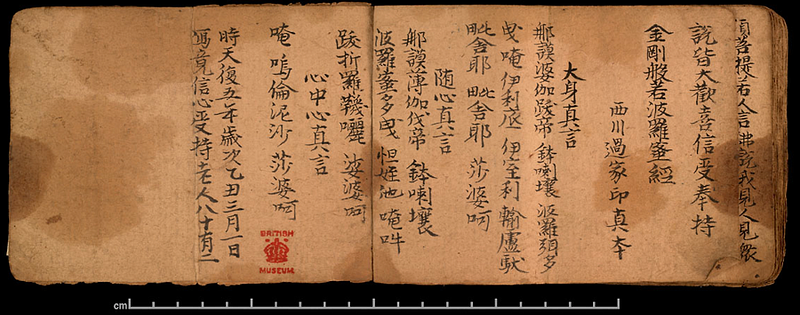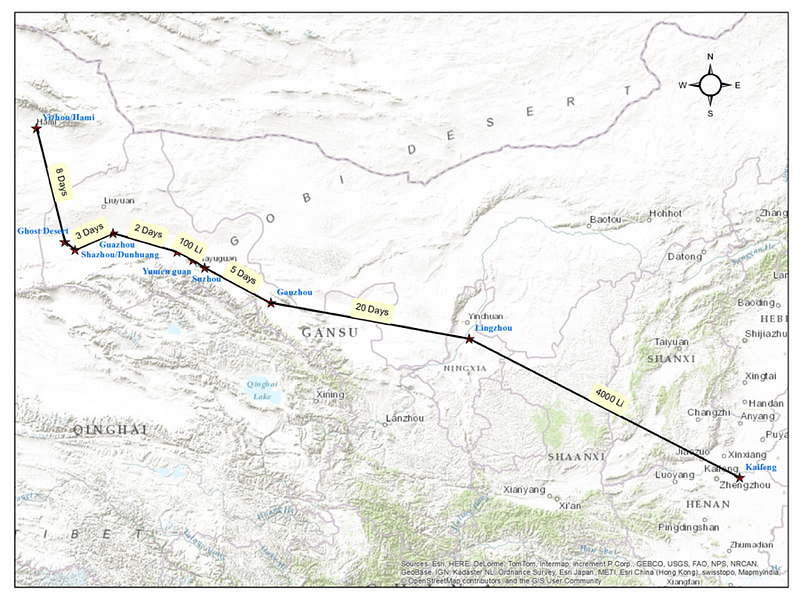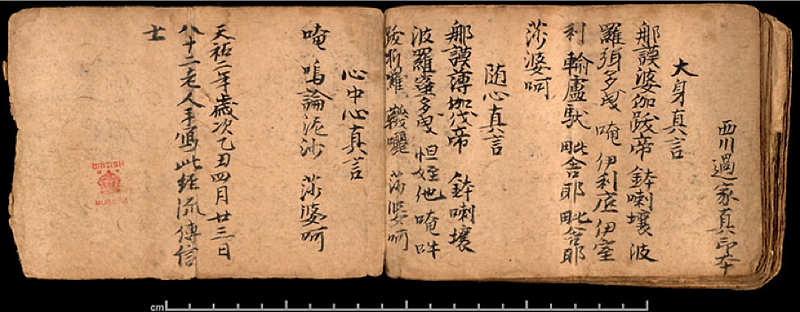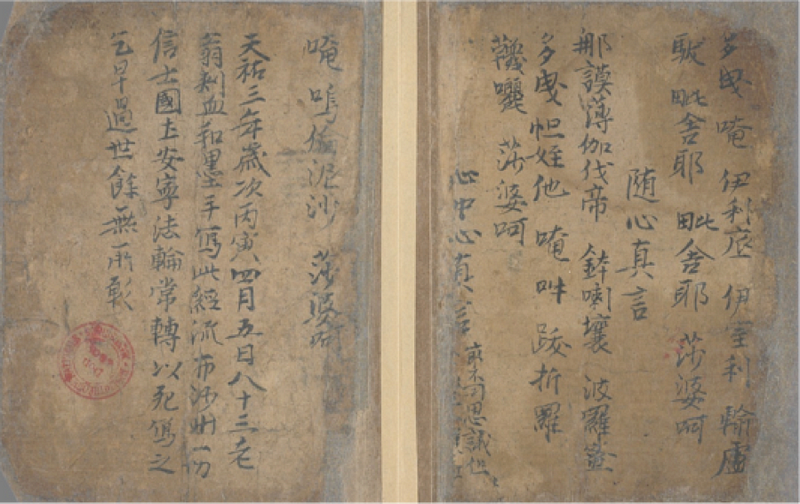Xin Wen, Ph.D. candidate in the Committee on Inner Asian and Altaic Studies, describes manuscripts discovered in the Dunhuang caves that tell us about one man’s personal experience of the fall of the Tang Dynasty.
On the eighth day of April in 905 (1st day of the 3rd month), an un-named, 82-year-old man copied the Chinese version of the Diamond Sūtra onto a small codex (Figure 1). This copy is the earliest one in a group of at least a dozen similar copies of Diamond Sūtra made by this same man between 905 and 911. In the early 11th century, all of these codices were sealed in the “library cave” of Dunhuang, an oasis town on the edge of eastern Central Asia, and re-discovered in 1900.
Around the same time, one thousand miles away, the Tang dynasty (618–907) fell. This event marks not only the official end of an imperial world system that ruled much of Eastern Eurasia for the previous three centuries, it is also a key moment in the seismic “Tang-Song transition” in the political as well as cultural histories of China. Was this man aware of the fall of the Tang? Did the great medieval cultural transition of China leave any traces in his life or the books he copied?
There is indeed no reason to assume that the fall of the Tang would have any impact on him. Physical distance was not the only thing that separated this man from Chang’an, the capital of the Tang. As a late 10th century Dunhuang geographical manuscript titled A Path to India (西天路竟) shows, the trip from central China to Dunhuang (see Figure 2) would take one through various towns in modern Ningxia and Gansu provinces. None of these places, in the early 10th century, were under the direct rule of the declining Tang empire. Many of them, such as the Uyghur state of Ganzhou, were ruled by non-Chinese regimes. So even though the state of Dunhuang still adhered to nominal vassal status, it was in no way under the control of the Tang.
Yet in the copies of the Diamond Sūtra by this man, the fall of the Tang does find the subtlest of expressions. Such expression is only clear when one understands how he perceived of time according to official Tang rules. Because of the distance between Dunhuang and the capital Chang’an, the news of a new reign name of the Tang — the standard system of dating in pre-modern China — often reaches him very slowly. The copy shown above, for instance, was written “in the 5th year of the Tianfu reign.” But the Tianfu reign only officially lasted for four years, and the year 905, according to the official Tang government, should have been the 2nd year of the Tianyou reign. Between this first copy and the second copy he made 53 days later (Figure 3), however, he became aware of this change in reign names, and switched the year to the “2nd year of the Tianyou reign.”
In 907, he abandoned the use of reign names altogether, and switched to the apolitical ganzhi system (a way of reckoning time using sixty unique combinations of terms). Importantly, this action occurred a few months before the dethronement of the last Tang emperor by Zhu Wen (852–912) and the official end of the Tang. The news of Zhu’s new dynasty therefore could not have been the reason for this change. Why did he make this change? Did he already sense the imminent fall of the Tang a few months before it actually occurred? There is no way for us to know the answer. The last time residents of Dunhuang switched to the ganzhi system en masse as their method of dating was when the Tibetan empire conquered Dunhuang in the late 8th century. Therefore, from this small change, it appears that this man in Dunhuang may have been cognizant of the political drama unfolding in Central China. He was connected to Central China in ways we cannot know.
Another way he was connected to Central China is hinted at in his colophons. According to his own notes, this man made the copies of the Diamond Sūtra on the basis of “an authentic version printed by the Guo family in Xichuan (modern western Sichuan) 西川過家印真本” (See Figure 1). As the 868 copy of Diamond Sūtra (Or.8210/P.2) — often seen as the earliest extant printed book in the world — shows, this text was already printed in Dunhuang in the mid-9th century. Yet this man used the print imported from Sichuan, some 1300 miles away. This Sichuan version is no longer extant, but judging from the copies this man made on its basis, this version must have been in codex form, and contained a different set of mantra (zhenyan 真言, Buddhist hymn) at the end of the text. The man might have found this text more appealing for these reasons, or perhaps the 868 copy or similar copies printed in Dunhuang were simply unavailable to him?
Whatever the reason for copying from an imported print, his copies show that the transition from manuscript to printing — a significant component of the broader cultural shifts in the “Tang-Song transition” — is a lot more complicated than is sometimes assumed. In a manner that seems to reverse technological progress, he used printed texts and made them into manuscripts. Interestingly, however, he did identify the printed version as “authentic (印真本 or 真印本),” perhaps recognizing the apparent stability of printed text in comparison to the variability of manuscript. This model of the dissemination of books in the era of transition, in which printed texts were being disseminated trans-regionally, while manuscripts were copied locally, might help raise new questions about the social impact of printing in Middle Period China.
But perhaps more important than complicating our existing historiographical narratives about the era, this series of copies of the Diamond Sūtra offers some rare glimpses into the life of an ordinary person that are sometimes profoundly touching. He prayed in later colophons that his old ox will be reborn in the pure land of the west, and will not suffer being reborn as an animal again (Stein 5544). He prayed too for his enemies and debtors, so that their offenses as severe as defiling a monastery might be absolved (Stein 5450). At the end of a 906 copy, he left the following colophon (Figure 4):
八十三老翁刺血和墨,手寫此經,流布沙州一切信士,國土安寧,法輪常轉,以死寫之,乞早過世,餘無所願。
This 83-year-old man mixed blood with ink, and copied this sutra by hand in order that it be distributed to all the faithful ones in Shazhou (Dunhuang). May the land of the state be peaceful, and the wheel of the dharma turn in perpetuity. I copied it with (the wish for) death. Other than a swift departure from the world, there is nothing more that I desire.
The apparently resolute wish for the other world and his sensitive perception about this world are not necessarily contradictory. By mixing his blood with the ink and stressing that the text was copied by hand, his own body became deeply entangled in the process of making this text. Hence, although a copy of the Diamond Sūtra, this text differed fundamentally from mass-produced printed texts made by the Dunhuang government at the time. Perhaps only in this way could he hope to compete with the well-funded projects of printing in the race for merit?
Xin Wen previously spent a summer researching at the British Library’s Asian and African Studies center, funded by Harvard’s Fairbank Center. Read his account on Manuscripts and Digital Humanities at the British Library.




No comments:
Post a Comment